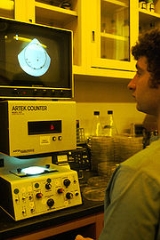
Colony counter
Encyclopedia
A colony counter is an instrument used to count colonies
of bacteria
or other microorganism
s growing on an agar plate
. Early counters were merely lighted surfaces on which the plate was placed, with the colonies marked off with a felt-tipped pen on the outer surface of the plate while the operator kept the count manually. More recent counters attempt to count the colonies electronically, by identifying individual areas of dark and light according to automatic or user-set thresholds, and counting the resulting contrasting spots.
The maximum number of colonies which may be effectively counted on a single plate is somewhere between 100 and 1,000, depending on the size of the colony and the type of organism.
Colony (biology)
In biology, a colony reference to several individual organisms of the same species living closely together, usually for mutual benefit, such as stronger defense or the ability to attack bigger prey. Some insects live only in colonies...
of bacteria
Bacteria
Bacteria are a large domain of prokaryotic microorganisms. Typically a few micrometres in length, bacteria have a wide range of shapes, ranging from spheres to rods and spirals...
or other microorganism
Microorganism
A microorganism or microbe is a microscopic organism that comprises either a single cell , cell clusters, or no cell at all...
s growing on an agar plate
Agar plate
An agar plate is a Petri dish that contains a growth medium used to culture microorganisms or small plants like the moss Physcomitrella patens.Selective growth compounds may also be added to the media, such as antibiotics....
. Early counters were merely lighted surfaces on which the plate was placed, with the colonies marked off with a felt-tipped pen on the outer surface of the plate while the operator kept the count manually. More recent counters attempt to count the colonies electronically, by identifying individual areas of dark and light according to automatic or user-set thresholds, and counting the resulting contrasting spots.
Microorganism enumeration
Such counters are used to estimate the density of microorganisms within a liquid culture. An appropriate dilution, or several dilutions within the estimated appropriate range, is spread using sterile technique on the agar plate, which is then incubated under the appropriate conditions for growth until individual colonies appear. Each colony marks the spot where a single organism was originally placed, thus the number of colonies on the plate equals the number of organisms within the volume of liquid spread on the plate. That concentration is then extrapolated by the known dilution from the original culture, to estimate the concentration of organisms within that original culture.The maximum number of colonies which may be effectively counted on a single plate is somewhere between 100 and 1,000, depending on the size of the colony and the type of organism.
See also
- Growth mediumGrowth mediumA growth medium or culture medium is a liquid or gel designed to support the growth of microorganisms or cells, or small plants like the moss Physcomitrella patens.There are different types of media for growing different types of cells....
- Petri dishPetri dishA Petri dish is a shallow glass or plastic cylindrical lidded dish that biologists use to culture cells or small moss plants. It was named after German bacteriologist Julius Richard Petri, who invented it when working as an assistant to Robert Koch...
- Replica platingReplica platingIn molecular biology and microbiology, replica plating is a technique in which one or more secondary Petri plates containing different solid selective growth media are inoculated with the same colonies of microorganisms from a primary plate , reproducing the original spatial...
- Viral plaqueViral plaqueA viral plaque is a visible structure formed within a cell culture, such as bacterial cultures within some nutrient medium . The bacteriophage viruses replicate and spread, thus generating regions of cell destructions known as plaques....

